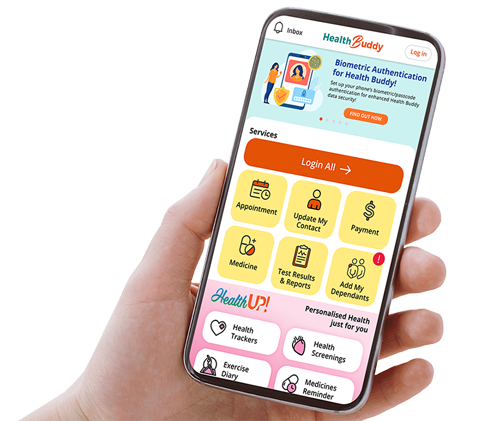
The Lymphoedema Service at Sengkang General Hospital is a multidisciplinary service that serves the needs of patients with diseases related to the lymphatic system.
We are committed to providing comprehensive and quality care to our patients with lymphatic-related problems, as well as patients who are at risk of developing them.
Our focus is on providing streamlined one-stop care that meets the unique needs of each patient, leveraging on our multidisciplinary team with a wide range of modern diagnostic, non-invasive and surgical techniques.
Our Vision
To serve the needs of our patients by preventing, treating, and advancing the care of lymphatic-related diseases in Singapore
Our Mission
Preventative treatment to decrease the risk of lymphoedema
Active surveillance and intervention to prevent deterioration
Early rehabilitation to restore function and quality of life
Continuing research to improve the quality of care through academic medicine
Patient Care Services
Outpatient Care
Our Lymphoedema Service offer a comprehensive approach to treating lymphedema. Our patients are seen in multidisciplinary clinics, where they will be evaluated by a team of specialists including a lymphatic specialist, physiotherapist, and occupational therapist. Together, they create a holistic care plan that combines both medical and surgical treatments to best meet the individual needs of each patient. This one-stop service is designed to provide highly specialised and effective care for those suffering from lymphedema.
Inpatient Care
We strive to provide the best care possible for lymphatic diseases through our emphasis on modern multidisciplinary care in our inpatient services. Our team utilises the strengths of each discipline to create a comprehensive treatment plan for each patient. This includes utilising advanced diagnostic services, comprehensive decongestive therapy, and supermicrosurgical techniques, allowing for a multi-pronged approach to treating lymphatic diseases. Through this approach, we aim to improve the quality of life for our patients.
Rehabilitation
Patients will benefit from streamlined inpatient rehabilitation services at the Sengkang General Hospital. This will increase their chances of returning to work and resuming their daily activities. Additionally, patients can receive further support and guidance through our “Return to Work” clinics, which are led by rehabilitation medicine specialists.
Conditions We Treat
Looking for other conditions?
Treatments Offered
Looking for other treatments?
FAQs
The lymphatic system is a complex circulatory system that transports protein-rich lymphatic fluids and can be found throughout the body. It also includes components of immune system, which include lymph node systems, and specialised organs like tonsils, spleen, adenoids, and thymus. In recent research, lymphatic vessels have been identified even within the brain, showing that the lymphatic system is a critical network crucial for normal functioning of the body.
Lymphoedema is swelling that is caused by a build-up of protein rich fluid in the body. This commonly happens in the limbs, especially the upper and lower limbs. In some situations, it can even occur in the head and neck region, or within the chest and abdomen. This build-up of protein rich fluids is caused by disruption to the lymphatic vessels, which prevent it from returning to the heart for circulation. With prolonged accumulation of protein rich fluids, chronic inflammation and scarring can occur, worsening the congestion. The affected area is also more prone to infection and ulceration.
The most common cause of lymphoedema in Singapore is from surgical removal of lymph nodes or radiotherapy. However, it can also be caused by infection or trauma to the lymph nodes or lymphatic vessels. In rare cases, it can also be a congenital issue, where the lymphatic vessels are not developed properly from birth.
- Heaviness of the limb
- Swelling of affected site, which is better in the morning but can worsen throughout the day
- Redness, warmth and pain at the affected limb
- Increase in size of the limb, which can make clothes difficult to fit in
Lymphoedema is diagnosed with specialised imaging studies. Nuclear medicine lymphoscintigraphy makes use of special dyes to detect the rate of lymphatic flow in the affected body part. Near infra-red ICG scans use a different type of dye to look at the pattern of superficial lymphatics. MRI lymphangiogram can be used to detect patency of deeper lymphatic channels.
Lymphoedema can be treated with non-invasive or surgical methods.
Non-invasive methods include comprehensive decongestive therapy, which comprises daily massage and compression garment. In Sengkang General Hospital, our certified lymphoedema therapists have undergone specialised training to provide this therapy for our patients.
- Liposuction
- Charle’s procedure
- where the affected skin is removed and replaced with skin grafts
- Radical Reduction of Lymphoedema with Preservation of Perforators (RRPP)
- where the affected fat is removed but the skin is left behind
- Vascularised Lymph Node Transfer (VLnT)
- Healthy lymph nodes from another location are transferred to the affected part
- Helps to regenerate new lymphatic tissue
- Vascularised Lymph Vessel Transfer (VLvT)
- Healthy lymphatic vessels from another location are transferred to the affected part
- Helps to promote lymphatic flow
- Lymphaticovenular Anastomosis (LVA)
- Using supermicrosurgery techniques to bypass the lymphatic fluid away from the obstructed area
- Lymph Node Venular Anastomosis (LnVA)
- Using supermicrosurgery techniques to decongest the lymph nodes which have been obstructed
In some clinical scenarios such as breast cancer treatment, preventative lymphatic bypass can be performed at the same time as breast cancer surgery. This will decrease the risk of lymphoedema developing in the upper limb.
Our Care Team
News

















